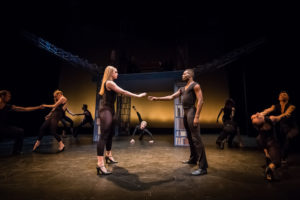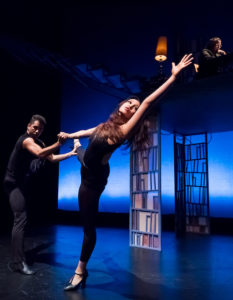In 1971 anthropologist Margaret Mead and writer James Baldwin met to talk about race. Their conversation took place over two and a half days and was released in audio only. Actress and playwright Anna Deavere Smith has used the tapes of this conversation over the past 30-plus years, in the classroom and on stage, its text morphing into various theatrical forms. In a recent version, the choreographer Donald Byrd used Deavere Smith’s version of the text as part of an 85-minute dance–theater piece. His motivation for doing so was to present a “model for conversations about race.”

Byrd is the founder and executive artistic director of the Seattle–based Spectrum Dance Theater. A prolific choreographer, he has been commissioned by numerous companies in the dance and theater worlds, including Joffrey Ballet, Alvin Ailey Dance Theater, San Francisco Opera and New York City Opera.
The Byrd–Deavere Smith adaptation of Rap on Race was presented this past weekend by Cal Performances at one of their four new Oakland venues, the Metro Operahouse in Jack London Square. The venue’s stripped-down warehouse look, brick wall acoustic vibrance and temporary bleachers for the audience provided a resonant backdrop to this edgy work. Edgy, not only in its spoken content but also in the dance and music that were spliced between passages of the Mead–Baldwin conversation.
The piece is staged on two levels. A large platform rises some 10 feet above the main stage with a cozy setting of two armchairs across from each other at a table, a lamp, a side table with books and bottles. The platform is supported by four screen-like pillars that are stylized representations of bookcases; their transparent, illuminated surfaces give them the quality of stained glass. In this homely scene Margaret Mead and James Baldwin confront each other.
Kathryn van Meter is Mead and choreographer Byrd acted the role of James Baldwin. Both interpretations were brilliant. Mead holds forth – contentious, pompous, and confident in her ideas, which by contemporary knowledge border on the ridiculous. And Baldwin counters – at first politely allowing her to assert her bizarre ideas, and then stating his own, delineating his racial reality with insistence. The intellectual fisticuffs are totally engaging.
What their conversation style has, according to Deavere Smith, is musicality. They proclaim, interrupt, talk over each other, defend and give way. Baldwin’s speech especially has a lilting quality, peppered with TransAtlantic vowel sounds and cigarette smoking coughs. This musicality is picked up in the dance interludes that happen below the conversational platform.

On the main stage, dressed in hipster uniform – the men in black pants, the women in sheer footless black tights and black heeled jazz shoes, everyone in various black tops – the dancers careen in confrontational duets, with the occasional solo and trio. Set to Charles Mingus’ The Black Saint and the Sinner Lady with its resolutely clamorous brass and snaky rhythms, Byrd’s choreography is a showy jazz dance with elements of modern and ballet. Byrd commented that his choreography for Rap on Race was based heavily on the work of Talley Beatty, the iconic choreographer of the mid 20th century, who originally studied and worked with Katherine Dunham and whose seminal choreography described the African-American experience. And there is much of Beatty in the choreography’s repeated long extensions, balanced rond de jambes and arched backs – a balletic quality that fit the long lean body of Beatty as a young man.
The choreography also echoed the topics discussed by Mead and Baldwin, exploring not only confrontation but also touch and the meaning of physical difference. The 13 company dancers were excellent, performing the demanding choreography with barely a flicker.
–Jaime Robles
